-
CENTRES
Progammes & Centres
Location
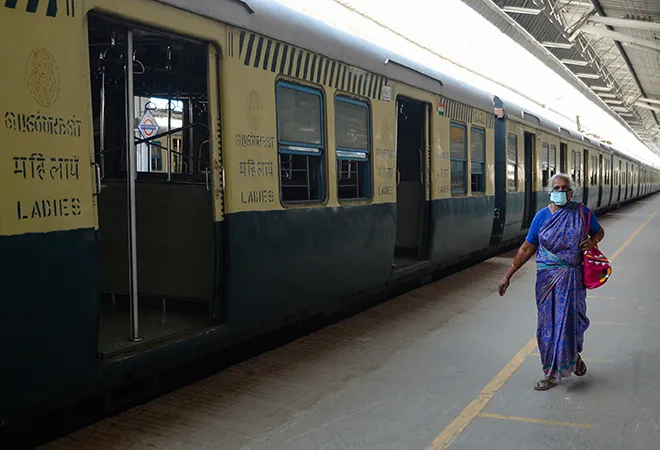
India’s Covid-19 situation has been improving for the last few months, with the number of active cases falling under 2 lakhs for the first time in the last seven months, and still declining. The daily number of recorded deaths is at the lowest in eight months (Figure 1). The overall test positivity rate has also declined in the meantime, indicating that the virus transmission is slowing down on the average in the country. The weekly test positivity rate has fallen below 2% continuing with a declining trend over the past weeks.
Figure 1: Daily Recorded Covid-19 Deaths in India
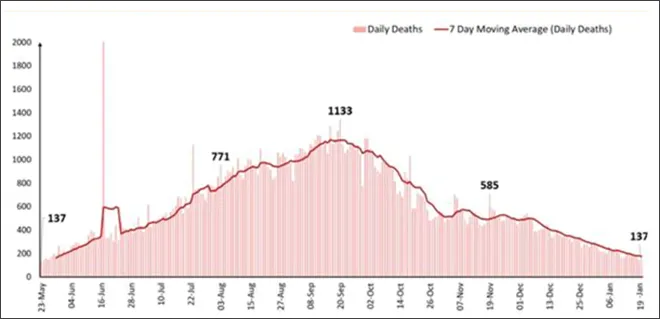 Source: Press Information Bureau: https://pib.gov.in/allRel.aspx
Source: Press Information Bureau: https://pib.gov.in/allRel.aspxSince almost two-thirds of the active cases and half the number of daily deaths in the country are concentrated in Kerala and Maharashtra, it is expected that for the most part of the country, the worst is certainly over. A look at the distribution of daily cases (Figure 2) shows that currently, India is at the same level of daily recorded cases as in June 2020. It is significant, as the pandemic is raging still in most parts of the world, and India till date accounts for about 12% of the global Covid-19 case load. India had reached from 4 to 5 million cases in just 12 days in September. However, in the month starting from mid-December, there have been only half a million new cases.
Figure 2: Daily Recorded Covid-19 Cases in India
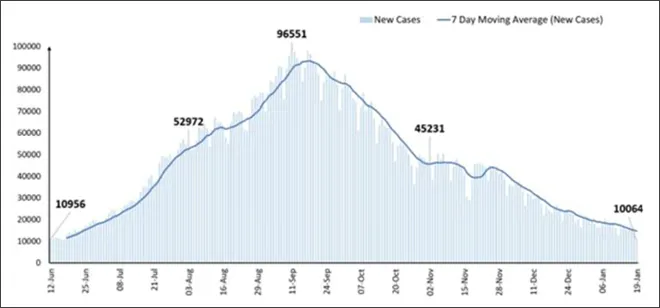 Source: Press Information Bureau: https://pib.gov.in/allRel.aspx
Source: Press Information Bureau: https://pib.gov.in/allRel.aspxAs the overall death rates have been low, and given the steady declining trend, despite having a large number of cases and deaths, both cases and deaths as proportions of population are the lowest in India amongst the high burden countries (Figure 3). It is likely that many asymptomatic cases are undetected but it is borne out in the test positivity rates that India does not have an invisible pandemic raging. Similarly, even when currently unaccounted Covid-19 deaths are added, the overall comparative situation will not change much.
Figure 3: Covid-19 Cases and Deaths Per Million Population in High Burden Countries
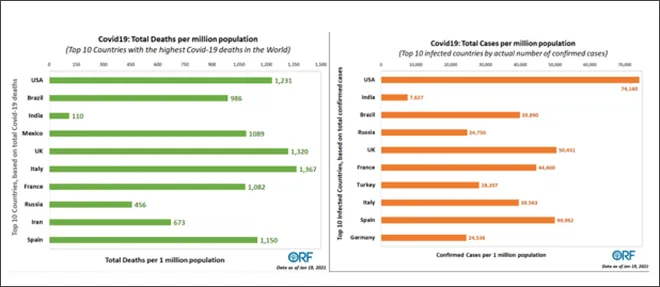 Source: Observer Research Foundation Covid19 Tracker at https://www.orfonline.org/covid19-tracker/
Source: Observer Research Foundation Covid19 Tracker at https://www.orfonline.org/covid19-tracker/Apart from a handful of states namely Kerala, Nagaland, Maharashtra and Goa, the positivity rates are very low, and much below the level of 5% which WHO suggests as the threshold to open up economies (Figure 4). Despite falling number of cases and deaths, India has still been testing aggressively, in view of the new strains of the virus. The latest weekly test positivity rate for India us under 2%, and only 13 states and UTs have a rate higher than the national average. The national average is pushed up disproportionately by cases from Maharashtra and Kerala.
Figure 4: Weekly Test Positivity Rates in States and UTs Showing Higher than National Average
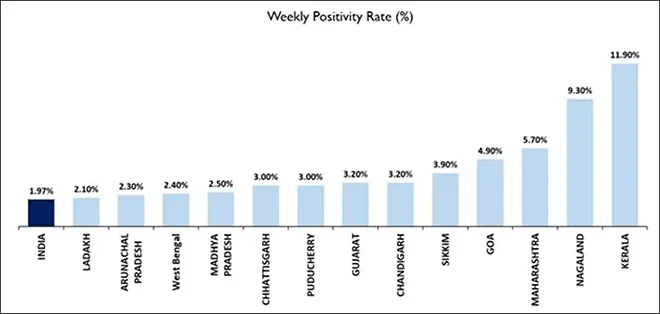 Source: Press Information Bureau: https://pib.gov.in/allRel.aspx
Source: Press Information Bureau: https://pib.gov.in/allRel.aspx For most parts of the country, the pandemic is under control and on the downswing. It is expected that by March, daily cases will fall to just a few thousands. Given the known limitations and bottlenecks in the Indian health system and despite some miscalculations along the way, India has done better than expected in its handling of the pandemic. What India did right can be summarised as follows:
On 16th January, India started a historic vaccination campaign, and till now about one million healthcare professionals are administered the first dose of the vaccine (Figure 5). Vaccination of high-risk categories among the general population is to start shortly. Despite some initial missteps during the approval process of vaccines, and a clear case of miscommunication on the true role of Covaxin in the vaccination rollout, most states are able to administer doses to a high proportion of the intended beneficiaries. However, low uptake among health professionals in states like Punjab and Tamil Nadu remains a concern, which need to be addressed soon.
Figure 5: Covid-19 Vaccine Doses Administered Per 1000 Population
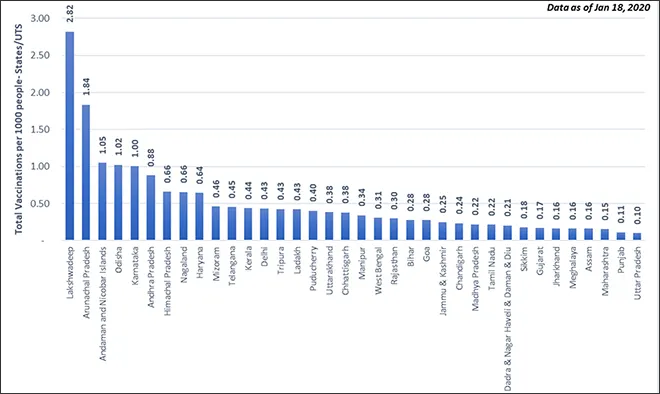 Source: Observer Research Foundation Covid19 Tracker at https://www.orfonline.org/covid19-tracker/
Source: Observer Research Foundation Covid19 Tracker at https://www.orfonline.org/covid19-tracker/Overall, opinion surveys indicate that a majority of the Indian public is satisfied with the government’s handling of the pandemic, and over the last three months the approval ratings have been going up (Figure 6). Earlier serosurvey results had indicated that the relatively poorer parts of India had not gained many benefits from the lockdown and other non-pharmaceutical interventions, and quite a few regions had very high levels of seropositivity. It is likely that even without vaccine, many pockets in India have already achieved herd immunity or are very close to it, through infection.
opinion surveys indicate that a majority of the Indian public is satisfied with the government’s handling of the pandemic, and over the last three months the approval ratings have been going up
Figure 6: Approval Rates of Government Response to the Pandemic
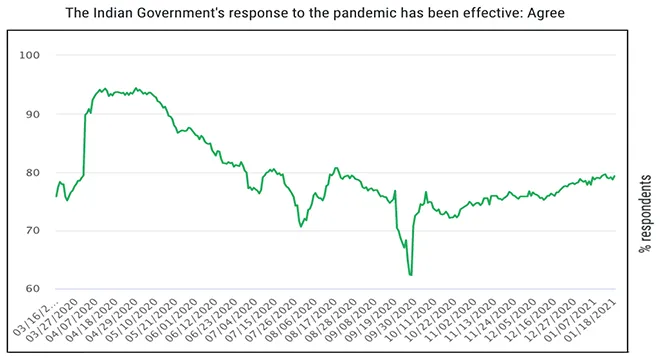 Source: Observer Research Foundation Covid19 Tracker at https://www.orfonline.org/covid19-tracker/
Source: Observer Research Foundation Covid19 Tracker at https://www.orfonline.org/covid19-tracker/Once vaccine is administered amongst the relatively vulnerable populations, the daily number of deaths will start declining quickly. Expanding government funded vaccination beyond high-risk populations is a decision that has to be made in the light of scientific evidence. In the absence of recent serosurveys, perhaps the existing levels of infection induced immunity can be gauged by observing the impact of potential superspreading events on case numbers. If events like Kumbh mela in Haridwar do not push up case numbers and deaths, it can perhaps be deduced that a large majority of the general population have already developed some immunity through infection. In that case, the ongoing vaccination drive should take us close to normalcy relatively early.
This commentary originally appeared in Manorama Yearbook.
The views expressed above belong to the author(s). ORF research and analyses now available on Telegram! Click here to access our curated content — blogs, longforms and interviews.

Oommen C. Kurian is Senior Fellow and Head of Health Initiative at ORF. He studies Indias health sector reforms within the broad context of the ...
Read More +